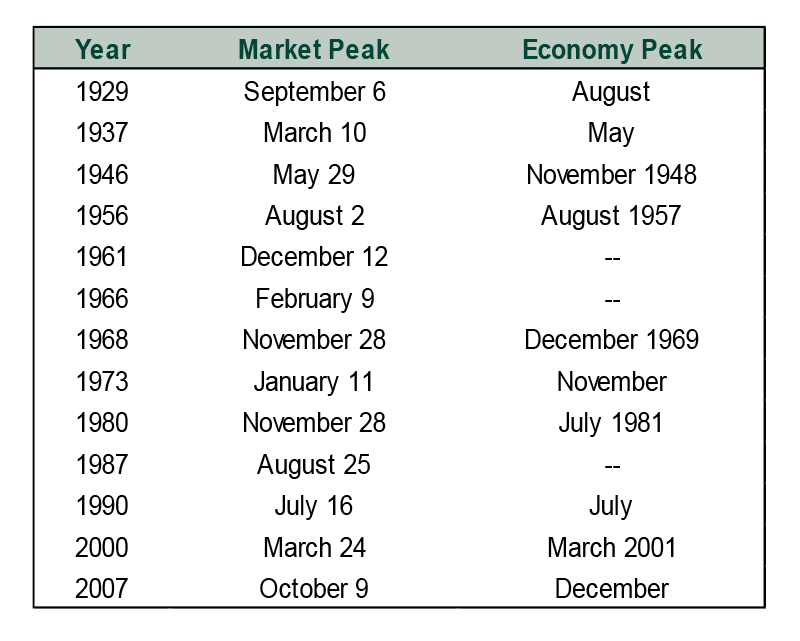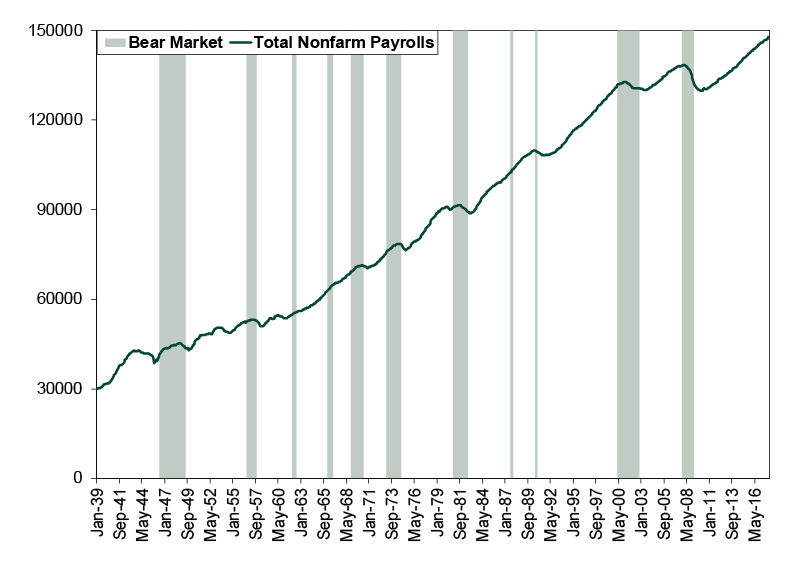Personal Wealth Management / Market Volatility
How Not to Identify a Bear Market
To assess whether a stock market decline is a correction or a bear market, you can’t rely on backward-looking economic data.
Accurately identifying a bear market in its early stages may help investors avoid some tough stock market losses. And while avoiding a bear isn’t necessarily required to achieve your long-term investment goals, it can certainly help. Unfortunately, doing so is very difficult and investors often struggle to recognize if a downturn is a bear—by definition a fundamentally driven stock market decline of 20% or more over an extended period of time , or a correction—a sharp sentiment-driven fall of 10% or more. For investors looking to identify whether a downturn is a correction or a bear market, understanding what can or can’t signify a bear is essential.
Dont' Use a Recession to Identify a Bear
One common misconception of bear markets is that they happen at the same time as the economy experiences a recession. While it is true that bear markets usually pair with recessions, they generally don’t start simultaneously. Stocks are a leading economic indicator. Bear markets usually begin months before recessions do. See Exhibit 1, which compares bear market and recession start dates since 1926.
Exhibit 1: Bear Markets Usually Begin Well Before Recessions Do

Source: FactSet and National Bureau of Economic Research, as of 2/13/2018. S&P 500 Index daily price level, 1926 – 2016.
Stocks also tend to peak long before employment does.
Exhibit 2: Nonfarm Payrolls and Bear Markets

If investors wait for confirmation of a recession before declaring a bear market, it could very well be too late to make it worth their while. While nailing the market’s peak isn’t necessary, getting out of stocks is wise only if there is still a high likelihood of significant downside to come. Keep in mind, recessions are visible only in hindsight. Because economic indicators are variable from month to month and quarter to quarter, a recession usually isn’t apparent until several months in, when it becomes clear market conditions are broadly deteriorating and it isn’t a blip. At that point, you could be six, eight or more months into a bear market. Some bears last long enough that this is still an attractive exit point—2000 comes to mind—but some are nearly over by the time a recession announces itself.
Do Use Forward-Looking Indicators
If avoiding part of a bear market is your aim, you must use forward-looking economic indicators to identify whether a recession is likely to develop—not backward-looking measures of past output and employment. The Leading Economic Index (LEI) is a helpful financial tool, as it aggregates 10 mostly forward-looking economic variables. It doesn’t predict stocks, as stocks are one of its 10 components, but it can help you gauge whether market volatility is noise or a signal of more serious economic trouble to come. The yield curve and inflation-adjusted monetary supply, which are also in LEI, are other good gauges. When the yield curve inverts (short interest rates exceeding long interest rates) and stays that way for a chunk of time, it usually means credit will tighten within the next several months—and tighter credit usually causes business activity to fall.
Other timely signs of trouble can be a sustained drop in manufacturing orders, a lengthy slide in the new business component of the Institute of Supply Management’s (ISM’s) non-manufacturing Purchasing Managers Index (PMI) and a broad drop in lending by financial institutions. These generally aren’t as forward-looking as market-based indicators, but they can precede declines in actual output.
Then again, this is all more art than science. There is such a thing as a recession-less bear, as 1987, 1966 and 1961 remind us. There is also such a thing as a bear-less recession, which happened in 1953, 1960 and early 1980. After all, economics are only one market driver—political conditions (e.g., legislative and regulatory risk) and investor sentiment have heavy influence too.
This isn’t to say you should ignore economic data when trying to identify a bear market. They can be very useful in determining market trends, confirming your earlier outlook or adding to your understanding of a key input for stocks. But when markets get rocky, solid GDP and employment numbers should be no comfort that a bear isn’t forming. Instead look at whether the yield curve slope is positive, whether LEI is high-and-rising, how strong loan growth is, whether there are strong new orders/new business readings and if legislative risk is relatively low. We believe these forward-looking data points help determine whether market volatility is sentiment driven, or volatility is due to a bear market forming.

See Our Investment Guides
The world of investing can seem like a giant maze. Fisher Investments has developed several informational and educational guides tackling a variety of investing topics.





